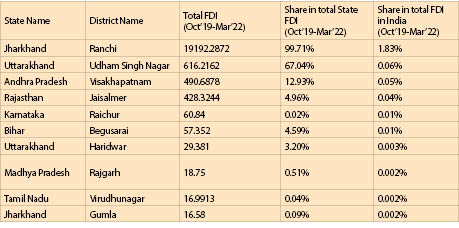With concerted efforts of the government, non-government organizations, and the community, the aspirational districts experienced more growth and development in the last three years than ever before.
The Government of India (GOI) launched the Aspirational Districts Programme (ADP) in January 2018 with the ambition of accelerating improvement in five socio-economic development parameters—health, education, agriculture, financial inclusion, skill development, and infrastructure—in 112 most backward districts of the country to ensure that SDG progress is localized at the district level. The core approach of the programme is based on the 3Cs of Convergence (of Central and State schemes), Competition (of Central, State level “Prabhari” Officers and District Collectors), and Collaboration (among districts through monthly delta ranking). The initiative builds on Prime Minister Narendra Modi’s principle of “Sabka Saath, Sabka Vikas, Sabka Vishwaas, Sabka Prayaas”.
With concerted efforts of the government, non-government organizations, and the community, the aspirational districts experienced more growth and development in the last three years than ever before. The United Nations Development Programme (UNDP), in its appraisal report, had said that India’s Aspirational Districts Programme has been “immensely successful in propelling development among the backward districts”. Given the positive impact of the programme on various socio-economic parameters, there were substantial positive spillovers to Foreign Direct Investment (FDI) in the districts.
A total of 23 aspirational districts received FDI equity inflows from October 2019 to March 2022. 3 of these districts are from Uttar Pradesh and Jharkhand each, 2 from Tamil Nadu, Rajasthan, Jharkhand, Uttarakhand, Punjab, and Andhra Pradesh, and 1 from Kerala, Karnataka, Bihar, Odisha, and Chhattisgarh. Ranchi (INR 19,192.3 crores), Udham Singh Nagar (INR 616.2 crores), and Vishakhapatnam (INR 490.7 crores) were the top 3 FDI recipients representing 99.71%, 67.04% and 12.93% of the total FDI in their respective states. Ranchi also represented a 1.83% share in the total FDI equity inflows of the country during the period of study. Udham Singh Nagar is the most lucrative industrial district in Uttarakhand. So far, the highest number of investment proposals in the state have been approved in the Udham Singh Nagar (2,379 proposals) with a total investment worth INR 4,536.2 crores and a proposed employment generation of 37,275 in the district. Vishakhapatnam is also one of the 100 cities under GoI’s Smart City program to drive economic growth and improve the quality of living through the application of smart solutions. About 48 smart projects in key sectors—such as health, IT, and energy—have been completed so far and 26 projects are in the work order stage in the district.
The districts have also outperformed across the five socio-economic sectors. This is encouraging since these are crucial areas for assessing development in the districts that might have led to a positive impact on the FDI performance of the districts. Almost all the districts that received FDI over the given period have significantly improved across all the parameters since the inception of the program. Chitrakoot, Sonbhadra, and Fatehpur, all from Uttar Pradesh, were among the top-performing districts since their inception in May 2022. Ranchi (Jharkhand) was the top performing district in Health and Nutrition parameter. Sonbhadra (UP) and Kalahandi (Odisha) were ranked in 7th and 10th position, respectively, for the same parameter. Likewise, Jaisalmer (Rajasthan), Sonbhadra (UP), and Chitrakoot (UP) were the top 7th, 9th, and 10th performing districts since their inception in education.
Research has shown that socio-cultural and economic variables like education and urbanization have a measurable effect on FDI. ADP has been successful in bringing FDI to the districts that responded positively to the program and have significantly improved across key socio-economic dimensions. Furthermore, FDI is shown to influence socio-economic growth in the host regions. Hence, it may also be true that the increase in FDI has helped drive the benefits of the program leading to a positive feedback cycle.
DPIIT started releasing district-wise FDI data in October 2019. The data is still at a very early stage to make any definitive conclusion. However, the positive trends that have emerged from the present analysis make a promising case for the future. As more granular data is released in the coming few years, we will be able to draw better conclusions on the correlation between effectiveness of ADP in improving the socio-economic parameters of districts and upsurge in the FDI levels in those districts.
Given the success of ADP in promoting growth and development in the districts, it should serve as a best practice model to be scaled up and replicated in several other regions of the country. The Centre has already identified 213 “low performing” districts and 500 “backward blocks” for scaling up the Aspirational Districts Model.
Bhavya Tyagi is a researcher at the Strategic Investment Research Unit of Invest India, Government of India’s National Investment Promotion Agency.

